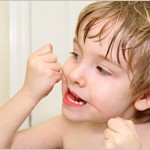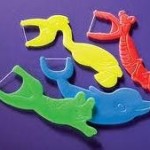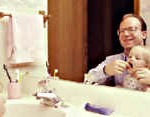Flossing is an essential part of your child’s self-care routine. Flossing prevents the buildup of plaque on and between the teeth.
Plaque is a sticky yellow substance that forms on teeth after eating carbohydrates such as bread, milk, raisins, soft drinks, cakes and candy. If not removed by brushing and flossing, bacteria grows on the plaque, forming an acid that leads to tooth decay. Plaque can even get down past gums and destroy the root and damage the bone supporting the teeth.
Teaching your child to floss once a day after brushing will help prevent cavities and help keep that beautiful smile beautiful!
Preschool
Young babies need us to care for their teeth until around age two. Cleaning your baby’s teeth with a soft washcloth held over one finger will get him used to oral care. As soon as two teeth appear you can begin flossing gently.
Children need help with brushing until about age 3 or 4. They will not be able to floss effectively until age 8 or 9. Until then you need to perform flossing every night before bedtime, right after a good two minute brushing.
Sit with your child on your lap facing you. You can use a floss holder, which may make it easier for your child to start trying herself. If you are flossing her teeth for her instead, follow this flossing technique taken directly from Colgate’s World of Care “Oral and Dental Health at Any Ageâ€:
- Take about 18 inches of dental floss and wrap one end around each of your middle fingers.
- Using your thumbs and index fingers as guides, gently slide the floss between two teeth, using a saw-like motion.
- Once at the gum line, pull both ends of the floss in the same direction to form a C shape against one tooth.
- Pull the floss tightly and move it up and down against one tooth.
- Pull the floss against the other tooth and repeat the motion.
- Repeat this for all of the teeth. Be sure to floss both sides of the teeth farthest back in the mouth.
Doing this every night before bed will provide the pattern needed to help your youngster develop good oral hygiene habits. If you are doing it for her, be careful not to force the floss between teeth if they are very close together and tightly spaced. If the floss is forced and then hurts her gums, it may cause bleeding, which will hurt and make her less likely to sit still for it. If you force the floss between the teeth and it makes the gums bleed, you might turn your child off to flossing, leading him to believe that flossing is a painful procedure. Flossing shouldn’t hurt.
Also remember to use a new section of floss each time you go between the next two teeth. If you use the same section of floss for the whole mouth, or even for a while, you could spread harmful bacteria from one location in the mouth to another.
Grades K-3rd
Young school age children are beginning to brush their own teeth. They still need help flossing until 8 or 9 years old.
It is helpful to have your child watch you floss your own teeth. Watching the grip and motions used will help them when it is time to take on this task.
When your child seems ready to floss, schedule a trip to the dentist. Have the hygienist instruct your child on the correct method of flossing. Hopefully the hygienist will let your child show her how they do it so correction can occur before ineffective methods become habit.
Go to the store together and purchase floss just for your child. They will feel proud being able to perform this task independently.
You will need to continue to supervise your child and check for completeness until you are sure they are consistently doing a good job.
Grades 4-6th
Children this age may still need to be reminded to floss, but for most the habit will be in place. Make sure your child has their own oral care supplies and that they are brushing at least twice a day and flossing every night before bed.
Having a small travel case for sleepovers will promote oral care when your child is not with you. Your child may even want to take a brush, toothpaste and floss to school with them.
The dentist will be able to tell if flossing has been done correctly. If necessary, have the dentist or hygienist review the technique during visits.
Helping your child develop good oral habits will give you the satisfaction of knowing you’ve given them a good start on keeping that beautiful smile beautiful!


